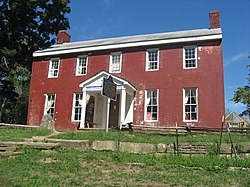John Work House and Mill Site
|
John Work House and Mill Site
|
|

John Work House in 2012
|
|
| Location | Northern side of Tunnel Mill Rd., west of Fourteen Mile Creek and northeast of Charlestown, Charlestown Township, Clark County, Indiana |
|---|---|
| Coordinates | 38°28′54″N 85°37′34″W / 38.48167°N 85.62611°WCoordinates: 38°28′54″N 85°37′34″W / 38.48167°N 85.62611°W |
| Area | 23 acres (9.3 ha) |
| Built | 1811 (house), 1814 (mill) |
| Architect | John Work |
| Architectural style | Federal |
| NRHP Reference # | 00001546 |
| Added to NRHP | January 3, 2001 |
John Work House and Mill Site is a site listed on the National Register of Historic Places in Indiana just outside Charlestown, owned by the Lincoln Heritage Council, (BSA), as part of the Tunnel Mill Scout Reservation. For a century, it was an active gristmill until technology made it obsolete, and arson destroyed much of it. Prominent features around the site are Fourteen Mile Creek and the Devil's Backbone. The land is now used by the Boy Scouts of America for camping activities such as National Youth Leadership Training and a Webelos Camp. In 2010, part of the Tunnel Mill camp was leased to a private company for the purpose of restoring the Historic John Work House for use as a living history center. In order to prevent vandalism and amateur ghost hunters from further damaging the building, security guards patrol the property each night.
The house was built in 1811. John Work (b. December 9, 1760) used virgin poplar forest to make 4 inches (100 mm) by 8 inches (200 mm) boards. It was originally two story/six room house with chimney for each room that if built today would cost several million dollars.
In 1814 John Work (1760–1834) decided to build a new gristmill, to replace the one he had bought in 1804 from the brothers John and James Bates, for which he paid $10 an acre 100 acres (0.40 km2), but needed repair. It was near the only road leading from Charlestown and New Washington to the growing Madison. Spotting where Fourteen Mile Creek made a S-curve around a limestone ridge and then dropped drastically, five miles (8 km) upcreek from the Ohio River, he decided to create a tunnel through a spur of a hill to act as a mill race, which would mean a better source of water to power his mill. The race was completed in 1816, and the mill itself in 1818. A total of 650 pounds (290 kg) of powder made from saltpeter was used for the tunneling. The total cost was estimated at $3,300. The race was 6 feet (1.8 m) deep and 5 feet (1.5 m) wide; a 200 lb (91 kg) man reportedly rode through it on opening day. A dam was later built for better year around use. Work would be credited for building three more mills upstream.
...
Wikipedia



